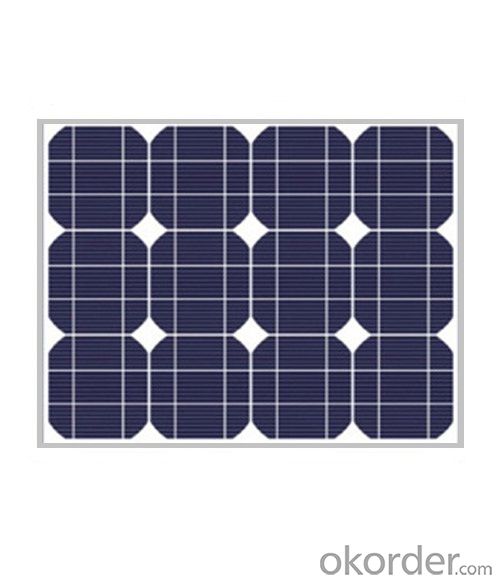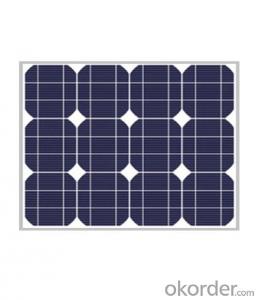Monocrystalline Silicon Solar Module 20W
- Loading Port:
- Shanghai
- Payment Terms:
- TT OR LC
- Min Order Qty:
- 10000 watt
- Supply Capability:
- 1000000 watt/month
OKorder Service Pledge
OKorder Financial Service
You Might Also Like
Item specifice
Product Description

Monocrystalline Silicon Solar Module 20W
Product Description
High efficiency and good workmanship
excellent in quality and reasonable in price
High transmission rate,low iron and tempered glass
solar panel have high wind,easy installation and long life.
Life time:20-25 years
Tempered glass laminated with aluminum frame
Specifications for Mono-crystalline Silicon Solar Module with 20W Maximum Power
| Mechanical Characteristics | |
| Cell type | mono-crystalline silicon solar cells |
| Cell layout | 2*18 |
| Number of cells | 36pcs |
| Module dimensions | 627*281*25mm |
| Frame | anodized aluminum,grey or black |
| Junction box | IP65 |
| Connectors | MC4 or MC4 compatible(optional) |
| Net weight | 2.20kg |
| Packing | 10pcs/ctn |
| Electrical Characteristics | |
| Peak power(Pmax) | 20W |
| Power tolerance | ±3% |
| Max.system voltage | 715VDC |
| Open circuit voltage(Voc) | 21.5V |
| Short circuit current(Isc) | 1.27A |
| Max.power voltage(Vmp) | 17.5V |
| Max.power current(Imp) | 1.14A |
| Temperature coefficients of Isc | 0.035%/ºC |
| Temperature coefficients of Voc | -0.33%/ºC |
| Temperature coefficients of Pmax | -0.43%/ºC |
| Cell Efficiency | ≥17% |
| FF | 73% |
| Standard Test Condition(STD) | Irradiance:1000W/m²;Cell temperature:25ºC;AM:1.5 |
Features:
1) High reliability with guaranteed +/-3% output power tolerance
2) The modules can withstand high wind-pressure, snow loads and extreme temperatures
3) Bypass diodes to minimize power loss with shading
4) High and stable conversion efficiency to ensure the highest quality
Quality and Safety
1) Industry leading power output warranty, 25 year 80%, 10 year 90% power warranty and 3 year power warranty
2) ISO9001: 2008 (Quality Management system) certified factory
3) Product Quality warranty & products Liability Insurance to guarantee and user' benefits
EN 6100-6-3: 2007 EN 6100-3-1: 2007(IEC 61000-4-2: 2008
Our advantages:
High quality materials: High insulation TPT, Anti-aging EVA
Focus on each process during manufacture
Experienced engineers and workers
Fast delivery: 7-15 DAYS High efficiency and long time warranty
- Q:my solar car works when using the Battery but when there is sunlight i connect the wires to the solar panel and it does not work...................HELP
- leave the car in the sun for a few hours to see if it charges. if not, the panel is defective. get it replaced b4 the science fair
- Q:Are there any noise or sound-related issues with solar panels?
- No, solar panels do not produce any noise or sound-related issues as they operate silently.
- Q:Can solar panels be used for powering Wi-Fi networks?
- Yes, solar panels can be used to power Wi-Fi networks. Solar panels generate electricity from sunlight, which can be used to power various devices, including Wi-Fi routers. This allows for the establishment of Wi-Fi networks in remote or off-grid locations where traditional power sources are either unavailable or unreliable. Additionally, solar-powered Wi-Fi networks are environmentally friendly and sustainable, as they utilize renewable energy sources.
- Q:Can solar panels be used on boats or marine applications?
- Yes, solar panels can be used on boats and marine applications. They are a sustainable and efficient way to generate electricity, especially in areas with ample sunlight. Solar panels can be easily installed on the deck or roof of a boat, providing power for various onboard systems such as lighting, navigation equipment, and charging batteries. Additionally, solar panels help reduce reliance on fossil fuels and minimize the carbon footprint of marine activities.
- Q:Can solar panels be installed on art installations or sculptures?
- Yes, solar panels can be installed on art installations or sculptures. In fact, integrating solar panels into art installations and sculptures has become a popular trend in recent years. This allows for the creation of sustainable and eco-friendly artworks that can generate renewable energy. Additionally, the combination of solar panels and art offers an innovative way to raise awareness about renewable energy and environmental issues.
- Q:If this was sold back to the grids what would be the profit i would stand to make per day on energy received in these panels? How did you come up with this answer?
- I'm putting in a $00,000 solar wind project on ST Thomas, Virgin Islands so I have some experience here..... ) depends on where you are...the further north the less efficient the panels are because early morning and late afternoon sun hitting at a great angle isn't anywhere near as good as noon hitting perpendicular..........the US Department of Energy has a solar calculator showing how many hours a day over the year you get enough sunlight to actually run the panels....in the Caribbean the answer is 6 so in Wisconsin you might only get 4 really usable hours a day, Nevada 5, Seattle...forget about it..... 2) the panels I'm putting in are ( roughly) 2 x 3 feet...you would need access around all four sides of a panel...you are NOT going to crawl 35 feet across an array to fix a unit in the middle......so lets say you get 35 panels tall ( 70/2) by 2 wide (3 foot with a 3 foot access area between each row = 72/6) or 420 panels. Each puts out 75 watts at max. So you are cranking out 73,500 watt hours, or 73kW. If your local utility buys back ( net metering ) the juice at, say, 20 cents a kWh, you get $4.75 an hour. If you have 4 usable hours a day x 365 x $4.74 you get back something like $20,000 a year. You pay about $7.00 a watt for a panel. The 75 watt panels are, rounding up, $200. each. Times the 420 panels number is $475,000 dollars. Add in about $2,000 for the inverter to change panel volts to power company volts, and maybe another $20,000 for installation you are looking at $500,000 AT LEAST to put in the system you propose. AT $20,000 a year in sales, its 20-25 years payback. Now, you can play with these numbers up and down but you still get the answer of A LOT of money to buy and build and a LONG time till payback.
- Q:If one buys tons of solar panels and sells electricity(possible in my country) can he earn money ?
- In theory, yes. But the fact that nobody is doing it implies there is something wrong with the idea. Solar panels are not exactly new.
- Q:How will i construct solar panel?
- For powering a something that works on DC, like a gate opener, Elaine is right, and in some cases only ONE bigger cell is sufficient due to battery storage; however if the appliance is 20v AC, then an inverter is needed also. MOST of Elaine's answer is good, but a few corrections are needed: Plywood - use EXTERIOR grade only, and even then it can warp; chipboard or waferboard is preferable as it does NOT warp, BUT is not available most places in 3/8, /2 nominal, (5/32) is usually the thinnest available, and it is heavier than plywood. DO NOT use particle board. Superglue - NO, it dries too fast to be useful, in most cases. Wires - For a single cell OK, but for larger panels the best wire is tabbing wire, (which is flat,) which is available from all commercial solar cell dealers. Be very careful soldering this to the cells, as unless you buy the expensive flexible cells, they are easily damaged; I suggest also getting flux pens with liquid flux. Diode - Necessary, but needs to be large enough to handle voltage and current. Usually 25v and 5-30 amps,, one per panel. Plexiglas - OK, but NOT as long lasting as glass; best glass is the special solar glass which is designed to pass almost all of the proper light frequencies, but IS expensive, and usually needs to be specially ordered since most glass stores do not stock it. Double panes work well with the outer pane glass and the inner plexiglas, (to protect the cell if glass broken,) IF where might get damage, such as 'ground' mounting. AND Frame kits are available for larger panels, but IF you make your own, a good table router is a great advantage. Inverter - IF used for 20v AC appliances you MUST have an inverter capable of handling the load, and the best ones are modified sine, or true sine, wave types, and even the best are less than 50% efficient. Note that they will last longer if NOT used at more than 2/3 capacity.
- Q:Can it be used on a cellphone so u never have to worry about low battery?
- Solar panels (arrays of photvoltaic cells) use renewable energy from the sun, and are a clean and environmentally sound means of collecting solar energy. Solar panels are a great way to generate electricity on a small scale. Solar panels are commonly named solar cells or photovoltaic cells. Photovoltaic means literally light electricity.” Solar cells or PV cells rely on the photovoltaic effect to absorb the energy of the sun and cause current to flow between two oppositely charged layers. Solar panel installation is a cost effective part of the green movement for saving energy. There are different types of solar panels available, including Monocrystalline Panels, Polycrystalline Panel, Cast Polycrystalline Panels, String Ribbon Silicone Panels and Thin Film Panels. Find more information about solar panels at this Web site:
- Q:Am using 800watts sukam inverter and have 55watts panel. What controller can i use to connect my solar system to have a max power . Already i have 200 Amp/hr battery
- You need a charger Controller but 55 watt panel is not a whole lot of power. So yes you can buy a very good one but it will cost a lot more. For a 55 watt panel you only need a 4 to 7 amp controller. But why not buy a 0 amp so you can add a second solar panel etc... A PWM (Pulse Width Modulated) is the cheapest and most robust type MPPT (Maximum Power Point Tracking) These controllers actually detect the optimum operating voltage and amperage of the solar array and match that with the battery bank. The result is additional 5-30% more power out of your array versus a PWM controller So unless you have a system over 200 watt the PWM works very good I have two of the PWM myself
1. Manufacturer Overview |
|
|---|---|
| Location | |
| Year Established | |
| Annual Output Value | |
| Main Markets | |
| Company Certifications | |
2. Manufacturer Certificates |
|
|---|---|
| a) Certification Name | |
| Range | |
| Reference | |
| Validity Period | |
3. Manufacturer Capability |
|
|---|---|
| a)Trade Capacity | |
| Nearest Port | |
| Export Percentage | |
| No.of Employees in Trade Department | |
| Language Spoken: | |
| b)Factory Information | |
| Factory Size: | |
| No. of Production Lines | |
| Contract Manufacturing | |
| Product Price Range | |
Send your message to us
Monocrystalline Silicon Solar Module 20W
- Loading Port:
- Shanghai
- Payment Terms:
- TT OR LC
- Min Order Qty:
- 10000 watt
- Supply Capability:
- 1000000 watt/month
OKorder Service Pledge
OKorder Financial Service
Similar products
New products
Hot products
Hot Searches
Related keywords



























